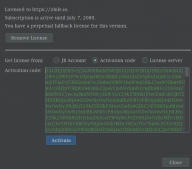首先说明下,下面两种方法均可以获得手机的mac地址,但是有个限制,是在iOS7以下才可以获得。iOS7以后苹果对于sysctl和ioctl进行了技术处理,MAC地址返回的都是02:00:00:00:00:00。
官方文档上这样写的:
"Twolow-level networking APIs that used to return a MAC address now return thefixed value 02:00:00:00:00:00. The APIs in question are sysctl(NET_RT_IFLIST) and ioctl(SIOCGIFCONF). Developers using the value of the MAC address should migrate toidentifiers such as -[UIDevice identifierForVendor].This change affects all apps running on iOS 7”。
所以在iOS7以后想要获取设备的唯一标示Mac地址已经不行了,只能用其他的代替。
下面说下两种方式:
都需要导入几个头文件
|
1
2
3
|
#include <sys/sysctl.h> #include <net/if.h> #include <net/if_dl.h> |
方法1:
|
1
2
3
4
5
6
7
8
9
10
11
12
13
14
15
16
17
18
19
20
21
22
23
24
25
26
27
28
29
30
31
32
33
34
35
36
37
38
39
40
41
42
43
44
45
46
47
48
49
50
51
52
|
// Return the local MAC addy // Courtesy of FreeBSD hackers email list // Accidentally munged during previous update. Fixed thanks to mlamb. - (NSString *) macaddress { int mib[6]; size_t len; char *buf; unsigned char *ptr; struct if_msghdr *ifm; struct sockaddr_dl *sdl; mib[0] = CTL_NET; mib[1] = AF_ROUTE; mib[2] = 0; mib[3] = AF_LINK; mib[4] = NET_RT_IFLIST; if ((mib[5] = if_nametoindex("en0")) == 0) { printf("Error: if_nametoindex error/n"); return NULL; } if (sysctl(mib, 6, NULL, &len, NULL, 0) < 0) { printf("Error: sysctl, take 1/n"); return NULL; } if ((buf = malloc(len)) == NULL) { printf("Could not allocate memory. error!/n"); return NULL; } if (sysctl(mib, 6, buf, &len, NULL, 0) < 0) { printf("Error: sysctl, take 2"); return NULL; } ifm = (struct if_msghdr *)buf; sdl = (struct sockaddr_dl *)(ifm + 1); ptr = (unsigned char *)LLADDR(sdl); NSString *outstring = [NSString stringWithFormat:@"%02x:%02x:%02x:%02x:%02x:%02x", *ptr, *(ptr+1), *(ptr+2), *(ptr+3), *(ptr+4), *(ptr+5)]; // NSString *outstring = [NSString stringWithFormat:@"%02x%02x%02x%02x%02x%02x", *ptr, *(ptr+1), *(ptr+2), *(ptr+3), *(ptr+4), *(ptr+5)]; NSLog(@"outString:%@", outstring); free(buf); return [outstring uppercaseString]; } |
方法2:
|
1
2
3
4
5
6
7
8
9
10
11
12
13
14
15
16
17
18
19
20
21
22
23
24
25
26
27
28
29
30
31
32
33
34
35
36
37
38
39
40
41
42
43
44
45
46
47
48
49
50
51
52
53
54
55
56
57
58
59
60
61
62
63
64
65
66
|
- (NSString *)getMacAddress { int mgmtInfoBase[6]; char *msgBuffer = NULL; size_t length; unsigned char macAddress[6]; struct if_msghdr *interfaceMsgStruct; struct sockaddr_dl *socketStruct; NSString *errorFlag = NULL; // Setup the management Information Base (mib) mgmtInfoBase[0] = CTL_NET; // Request network subsystem mgmtInfoBase[1] = AF_ROUTE; // Routing table info mgmtInfoBase[2] = 0; mgmtInfoBase[3] = AF_LINK; // Request link layer information mgmtInfoBase[4] = NET_RT_IFLIST; // Request all configured interfaces // With all configured interfaces requested, get handle index if ((mgmtInfoBase[5] = if_nametoindex("en0")) == 0) errorFlag = @"if_nametoindex failure"; else { // Get the size of the data available (store in len) if (sysctl(mgmtInfoBase, 6, NULL, &length, NULL, 0) < 0) errorFlag = @"sysctl mgmtInfoBase failure"; else { // Alloc memory based on above call if ((msgBuffer = malloc(length)) == NULL) errorFlag = @"buffer allocation failure"; else { // Get system information, store in buffer if (sysctl(mgmtInfoBase, 6, msgBuffer, &length, NULL, 0) < 0) errorFlag = @"sysctl msgBuffer failure"; } } } // Befor going any further... if (errorFlag != NULL) { NSLog(@"Error: %@", errorFlag); return errorFlag; } // Map msgbuffer to interface message structure interfaceMsgStruct = (struct if_msghdr *) msgBuffer; // Map to link-level socket structure socketStruct = (struct sockaddr_dl *) (interfaceMsgStruct + 1); // Copy link layer address data in socket structure to an array memcpy(&macAddress, socketStruct->sdl_data + socketStruct->sdl_nlen, 6); // Read from char array into a string object, into traditional Mac address format NSString *macAddressString = [NSString stringWithFormat:@"%02x:%02x:%02x:%02x:%02x:%02x", macAddress[0], macAddress[1], macAddress[2], macAddress[3], macAddress[4], macAddress[5]]; NSLog(@"Mac Address: %@", macAddressString); // Release the buffer memory free(msgBuffer); return macAddressString; } |
以上就是iOS获取手机的Mac地址的两种方法,希望对大家的学习有所帮助。





